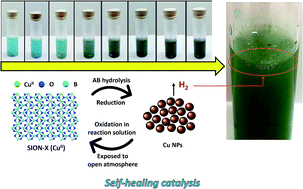Apr 11 2019
Scientists working within NCCR MARVEL have found a self-healing catalyst that can be used to liberate hydrogen via hydrolytic dehydrogenation of ammonia borane.
 (Image credit: NCCR Marvel)
(Image credit: NCCR Marvel)
The catalyst, SION-X—derived from the copious mineral Jacquesdietrichite—is air stable, sustainable, and can be easily regenerated, stored, and managed. These features suggest that it may provide considerable benefits over catalysts that are currently being used in the synthesis of the clean and renewable energy carrier hydrogen. The study has been reported in the Journal of Materials Chemistry A on April 9th, 2019 by Carey Sargent, EPFL.
Hydrogen (H2), a pure and renewable energy carrier, is regarded as a perfect candidate for future stationary and mobile applications. However, large-scale use necessitates secure and efficient storage and discharge of H2, and this continues to be a challenge despite the analysis of multiple systems of hydrogen storage.
In the last few years, some studies have been directed toward boron-nitrogen-based (B-N) hydride compounds as they can store and discharge a considerable amount of H2. Ammonia borane (AB), the simplest among the compounds, is specifically promising as it does not undergo self-hydrolysis in water. It has a low molecular weight, a high H2 content, exceptionally high stability in air as well as aqueous solutions, and is non-toxic, thus it holds great promise for on-board applications in transportation.
With regard to methods, hydrolysis at room temperature has been established to be the most benign and efficient technique for liberating hydrogen from AB, avoiding the use of high temperatures or any other harmful and expensive solvents. A catalyst is usually required however to boost the hydrolysis of AB.
Furthermore, when a range of catalysts that can release hydrogen efficiently from AB is present, they experience several drawbacks. Those based on noble metals are non-sustainable, costly, and unfeasible for large-scale applications.
Non-noble-metal catalysts are sensitive to air and can be oxidized easily, thus they need special handling and storage, and cannot be regenerated easily. Moreover, catalytic activity is partially reduced or even totally disabled following a few cycles of the reaction, for instance, in the case of earth-abundant transition metals.
These disadvantages forced the scientists, headed by Dr Kyriakos C. Stylianou of EPFL and NCCR MARVEL, to seek to find better catalysts. Suitable candidates must be air stable, based on abundant elements, and must be easily regenerated, stored, and managed. Among all these highlights, the scientists regarded regeneration, or self-healing—the potential of the catalyst to spontaneously repair itself during typical operations—as the most desirable trait. In fact, it is important for practical applications since the stability of the catalyst is directly associated with its economic viability.
Their new, self-healing sustainable catalyst, reported in the paper titled “Discovery of a Self-healing Catalyst for the Hydrolytic Dehydrogenation of Ammonia Borane,” appears to meet the bill. The catalyst, also known as SION-X, is the synthetic variety of the Jacquesdietrichite (Cu2[(BO)(OH)2](OH)3), a mineral first discovered in the Tachgagalt mine in Morocco in 1999. The researchers first acquired it as a blue powder after exposing the remnants of the reaction between a copper-based metal-organic framework (MOF) and AB to open air.
When they employed SION-X in the hydrolysis of AB, they achieved over 90% conversion of H2 in around 45 minutes. In the course of the process, it changed to copper(0) nanoparticles. On exposing the reaction mixture to air, the blue powder of SION-X was self-healed and regenerated from copper(0) nanoparticles. They were able to carry out 10 cycles of catalysis-regeneration without affecting the activity of SION-X.
This self-healing process, where the catalyst regained its structural integrity in open air without the application of heat, electrical bias, or pressure, is extremely essential for extending the lifespan of the catalyst and makes SION-X an ideal candidate for use in large-scale hydrolytic dehydrogenation of AB.
“The self-healing catalysis of SION-X in the absence of any extra energy input gives a new perspective in heterogeneous catalysis for energy-related applications,” stated the scientists.
The research was partly funded by NCCR MARVEL.